Critically Appraising Strategic Thinking and Systems Thinking
VerifiedAdded on 2023/04/21
|14
|4125
|218
Essay
AI Summary
This essay critically appraises the statement that systems thinking seeks to understand phenomena as a whole formed by the interaction of parts, in relation to changing ideas of strategic thinking and how it exists within a company’s approach to strategic management. It addresses key themes such as approaches to strategic thinking, systems thinking, complexity perspective, complex adaptive systems, and the practice perspective. The essay interprets how management varies in strategizing, conceptions of strategic management in relation to the environment, exploration of the business environment with strategic tools, strategic change management, and strategic risk management, concluding with the importance of strategic and systems thinking in today's dynamic business environment.

Running Head: STRATEGY PRACTICE 0
STRATEGY PRACTICE
STRATEGY PRACTICE
Paraphrase This Document
Need a fresh take? Get an instant paraphrase of this document with our AI Paraphraser
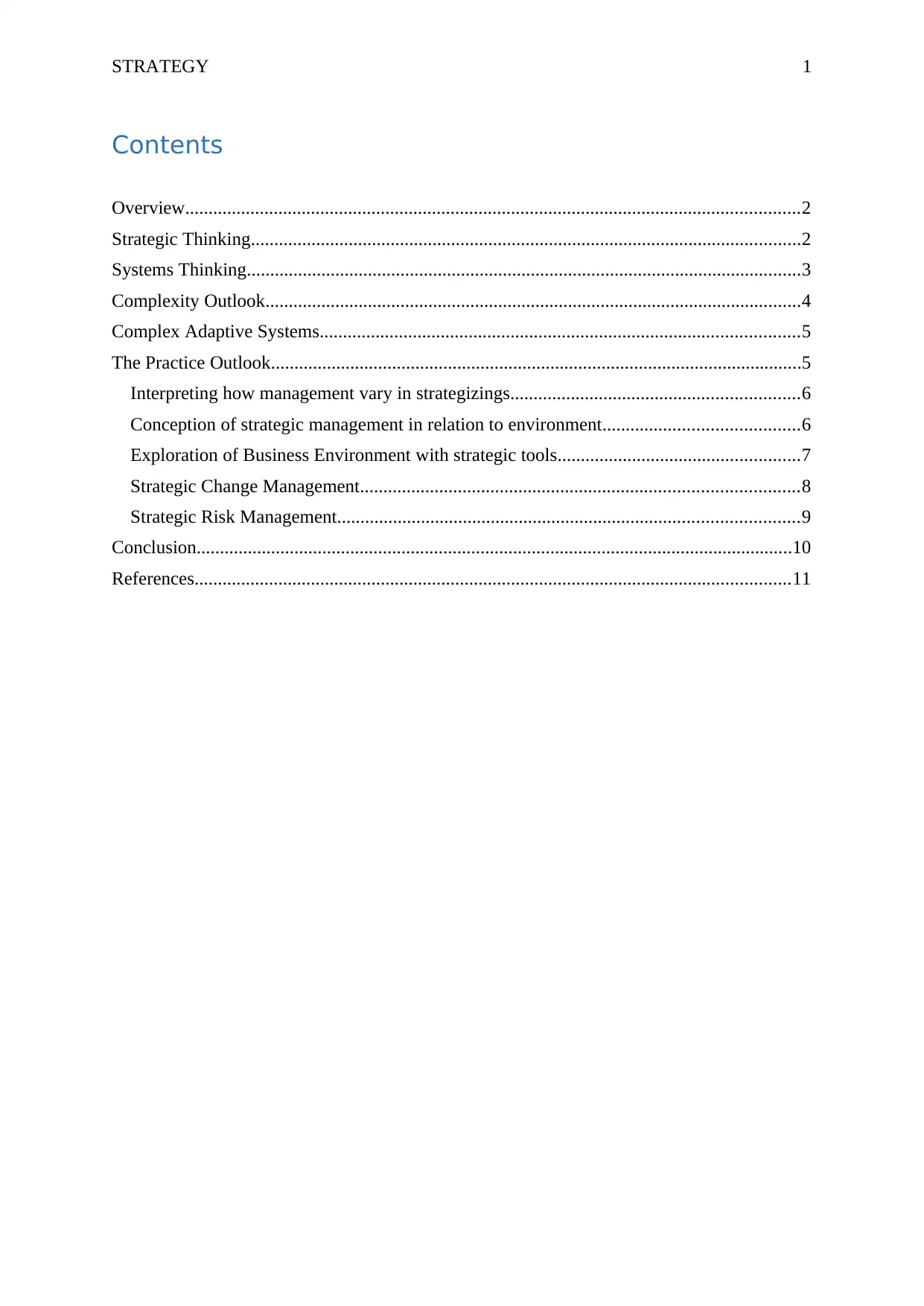
STRATEGY 1
Contents
Overview....................................................................................................................................2
Strategic Thinking......................................................................................................................2
Systems Thinking.......................................................................................................................3
Complexity Outlook...................................................................................................................4
Complex Adaptive Systems.......................................................................................................5
The Practice Outlook..................................................................................................................5
Interpreting how management vary in strategizings..............................................................6
Conception of strategic management in relation to environment..........................................6
Exploration of Business Environment with strategic tools....................................................7
Strategic Change Management..............................................................................................8
Strategic Risk Management...................................................................................................9
Conclusion................................................................................................................................10
References................................................................................................................................11
Contents
Overview....................................................................................................................................2
Strategic Thinking......................................................................................................................2
Systems Thinking.......................................................................................................................3
Complexity Outlook...................................................................................................................4
Complex Adaptive Systems.......................................................................................................5
The Practice Outlook..................................................................................................................5
Interpreting how management vary in strategizings..............................................................6
Conception of strategic management in relation to environment..........................................6
Exploration of Business Environment with strategic tools....................................................7
Strategic Change Management..............................................................................................8
Strategic Risk Management...................................................................................................9
Conclusion................................................................................................................................10
References................................................................................................................................11
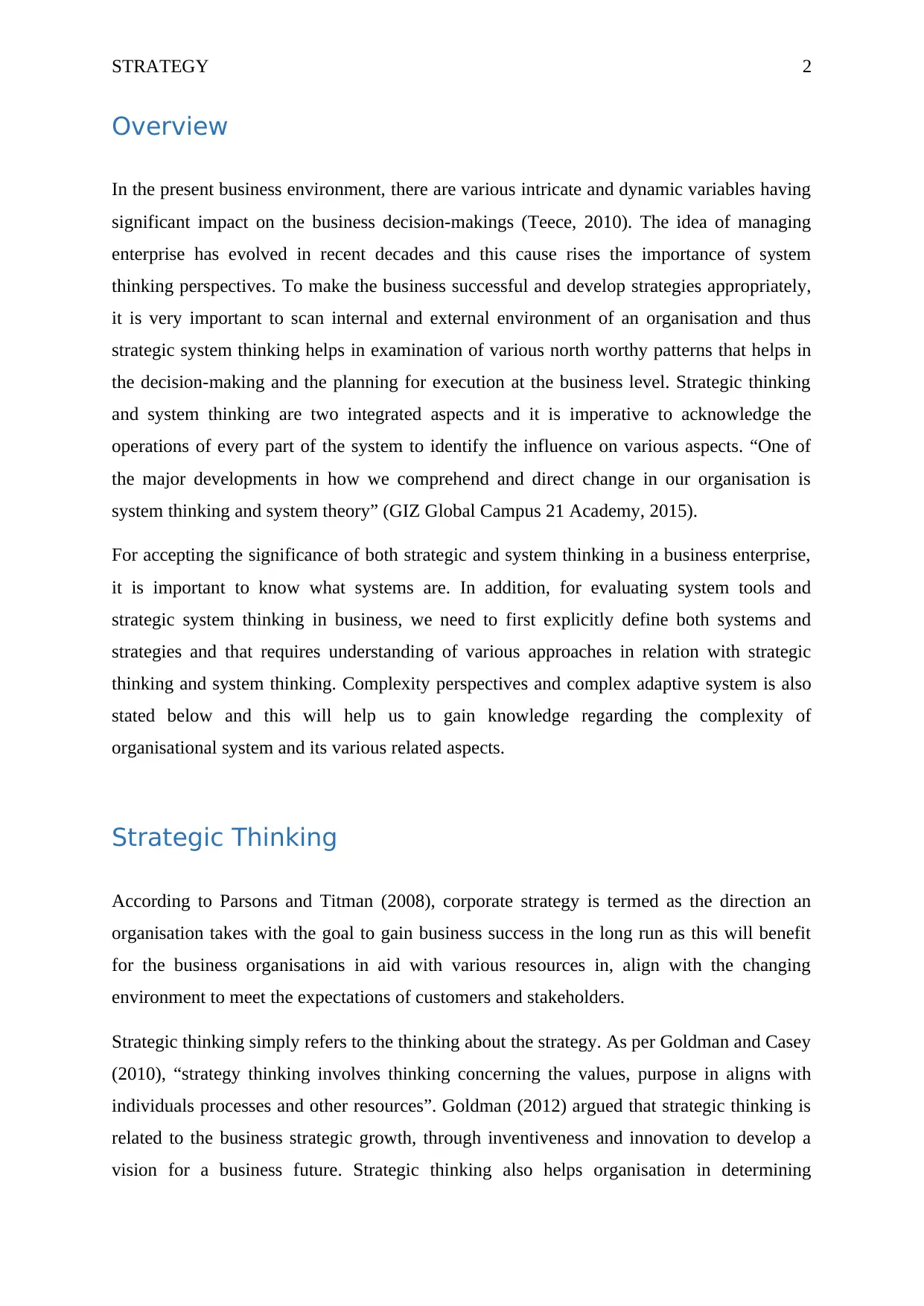
STRATEGY 2
Overview
In the present business environment, there are various intricate and dynamic variables having
significant impact on the business decision-makings (Teece, 2010). The idea of managing
enterprise has evolved in recent decades and this cause rises the importance of system
thinking perspectives. To make the business successful and develop strategies appropriately,
it is very important to scan internal and external environment of an organisation and thus
strategic system thinking helps in examination of various north worthy patterns that helps in
the decision-making and the planning for execution at the business level. Strategic thinking
and system thinking are two integrated aspects and it is imperative to acknowledge the
operations of every part of the system to identify the influence on various aspects. “One of
the major developments in how we comprehend and direct change in our organisation is
system thinking and system theory” (GIZ Global Campus 21 Academy, 2015).
For accepting the significance of both strategic and system thinking in a business enterprise,
it is important to know what systems are. In addition, for evaluating system tools and
strategic system thinking in business, we need to first explicitly define both systems and
strategies and that requires understanding of various approaches in relation with strategic
thinking and system thinking. Complexity perspectives and complex adaptive system is also
stated below and this will help us to gain knowledge regarding the complexity of
organisational system and its various related aspects.
Strategic Thinking
According to Parsons and Titman (2008), corporate strategy is termed as the direction an
organisation takes with the goal to gain business success in the long run as this will benefit
for the business organisations in aid with various resources in, align with the changing
environment to meet the expectations of customers and stakeholders.
Strategic thinking simply refers to the thinking about the strategy. As per Goldman and Casey
(2010), “strategy thinking involves thinking concerning the values, purpose in aligns with
individuals processes and other resources”. Goldman (2012) argued that strategic thinking is
related to the business strategic growth, through inventiveness and innovation to develop a
vision for a business future. Strategic thinking also helps organisation in determining
Overview
In the present business environment, there are various intricate and dynamic variables having
significant impact on the business decision-makings (Teece, 2010). The idea of managing
enterprise has evolved in recent decades and this cause rises the importance of system
thinking perspectives. To make the business successful and develop strategies appropriately,
it is very important to scan internal and external environment of an organisation and thus
strategic system thinking helps in examination of various north worthy patterns that helps in
the decision-making and the planning for execution at the business level. Strategic thinking
and system thinking are two integrated aspects and it is imperative to acknowledge the
operations of every part of the system to identify the influence on various aspects. “One of
the major developments in how we comprehend and direct change in our organisation is
system thinking and system theory” (GIZ Global Campus 21 Academy, 2015).
For accepting the significance of both strategic and system thinking in a business enterprise,
it is important to know what systems are. In addition, for evaluating system tools and
strategic system thinking in business, we need to first explicitly define both systems and
strategies and that requires understanding of various approaches in relation with strategic
thinking and system thinking. Complexity perspectives and complex adaptive system is also
stated below and this will help us to gain knowledge regarding the complexity of
organisational system and its various related aspects.
Strategic Thinking
According to Parsons and Titman (2008), corporate strategy is termed as the direction an
organisation takes with the goal to gain business success in the long run as this will benefit
for the business organisations in aid with various resources in, align with the changing
environment to meet the expectations of customers and stakeholders.
Strategic thinking simply refers to the thinking about the strategy. As per Goldman and Casey
(2010), “strategy thinking involves thinking concerning the values, purpose in aligns with
individuals processes and other resources”. Goldman (2012) argued that strategic thinking is
related to the business strategic growth, through inventiveness and innovation to develop a
vision for a business future. Strategic thinking also helps organisation in determining
⊘ This is a preview!⊘
Do you want full access?
Subscribe today to unlock all pages.

Trusted by 1+ million students worldwide
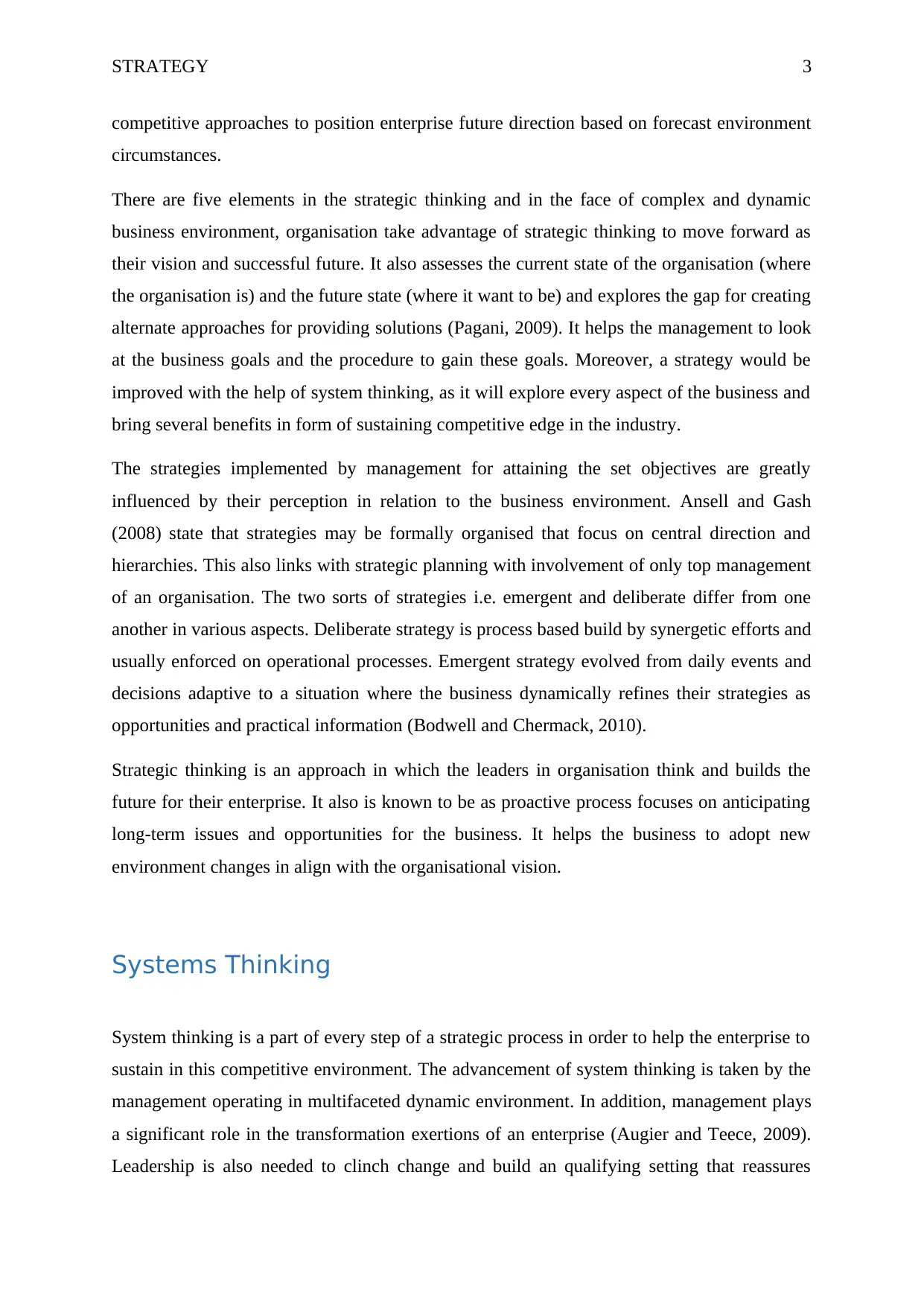
STRATEGY 3
competitive approaches to position enterprise future direction based on forecast environment
circumstances.
There are five elements in the strategic thinking and in the face of complex and dynamic
business environment, organisation take advantage of strategic thinking to move forward as
their vision and successful future. It also assesses the current state of the organisation (where
the organisation is) and the future state (where it want to be) and explores the gap for creating
alternate approaches for providing solutions (Pagani, 2009). It helps the management to look
at the business goals and the procedure to gain these goals. Moreover, a strategy would be
improved with the help of system thinking, as it will explore every aspect of the business and
bring several benefits in form of sustaining competitive edge in the industry.
The strategies implemented by management for attaining the set objectives are greatly
influenced by their perception in relation to the business environment. Ansell and Gash
(2008) state that strategies may be formally organised that focus on central direction and
hierarchies. This also links with strategic planning with involvement of only top management
of an organisation. The two sorts of strategies i.e. emergent and deliberate differ from one
another in various aspects. Deliberate strategy is process based build by synergetic efforts and
usually enforced on operational processes. Emergent strategy evolved from daily events and
decisions adaptive to a situation where the business dynamically refines their strategies as
opportunities and practical information (Bodwell and Chermack, 2010).
Strategic thinking is an approach in which the leaders in organisation think and builds the
future for their enterprise. It also is known to be as proactive process focuses on anticipating
long-term issues and opportunities for the business. It helps the business to adopt new
environment changes in align with the organisational vision.
Systems Thinking
System thinking is a part of every step of a strategic process in order to help the enterprise to
sustain in this competitive environment. The advancement of system thinking is taken by the
management operating in multifaceted dynamic environment. In addition, management plays
a significant role in the transformation exertions of an enterprise (Augier and Teece, 2009).
Leadership is also needed to clinch change and build an qualifying setting that reassures
competitive approaches to position enterprise future direction based on forecast environment
circumstances.
There are five elements in the strategic thinking and in the face of complex and dynamic
business environment, organisation take advantage of strategic thinking to move forward as
their vision and successful future. It also assesses the current state of the organisation (where
the organisation is) and the future state (where it want to be) and explores the gap for creating
alternate approaches for providing solutions (Pagani, 2009). It helps the management to look
at the business goals and the procedure to gain these goals. Moreover, a strategy would be
improved with the help of system thinking, as it will explore every aspect of the business and
bring several benefits in form of sustaining competitive edge in the industry.
The strategies implemented by management for attaining the set objectives are greatly
influenced by their perception in relation to the business environment. Ansell and Gash
(2008) state that strategies may be formally organised that focus on central direction and
hierarchies. This also links with strategic planning with involvement of only top management
of an organisation. The two sorts of strategies i.e. emergent and deliberate differ from one
another in various aspects. Deliberate strategy is process based build by synergetic efforts and
usually enforced on operational processes. Emergent strategy evolved from daily events and
decisions adaptive to a situation where the business dynamically refines their strategies as
opportunities and practical information (Bodwell and Chermack, 2010).
Strategic thinking is an approach in which the leaders in organisation think and builds the
future for their enterprise. It also is known to be as proactive process focuses on anticipating
long-term issues and opportunities for the business. It helps the business to adopt new
environment changes in align with the organisational vision.
Systems Thinking
System thinking is a part of every step of a strategic process in order to help the enterprise to
sustain in this competitive environment. The advancement of system thinking is taken by the
management operating in multifaceted dynamic environment. In addition, management plays
a significant role in the transformation exertions of an enterprise (Augier and Teece, 2009).
Leadership is also needed to clinch change and build an qualifying setting that reassures
Paraphrase This Document
Need a fresh take? Get an instant paraphrase of this document with our AI Paraphraser
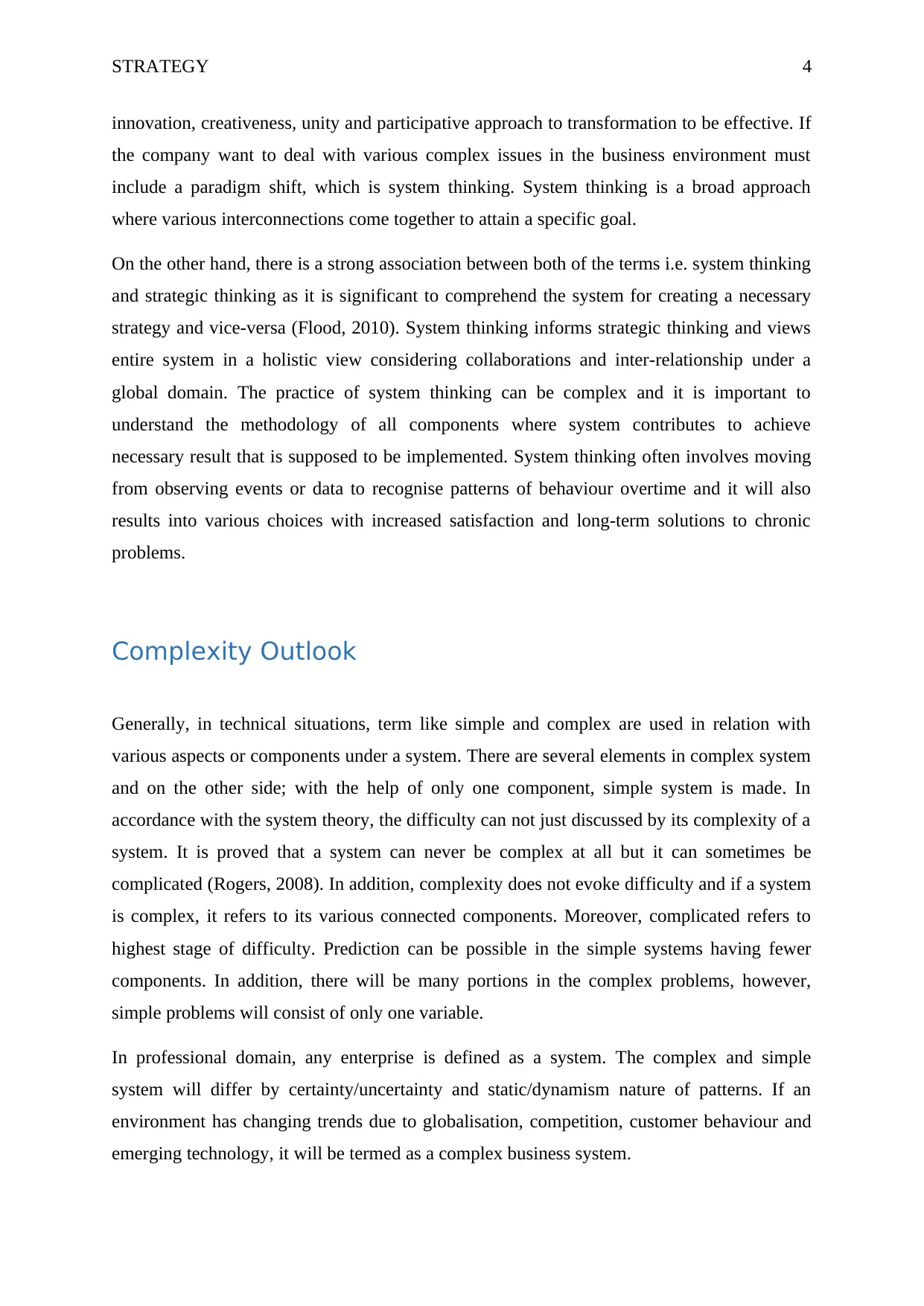
STRATEGY 4
innovation, creativeness, unity and participative approach to transformation to be effective. If
the company want to deal with various complex issues in the business environment must
include a paradigm shift, which is system thinking. System thinking is a broad approach
where various interconnections come together to attain a specific goal.
On the other hand, there is a strong association between both of the terms i.e. system thinking
and strategic thinking as it is significant to comprehend the system for creating a necessary
strategy and vice-versa (Flood, 2010). System thinking informs strategic thinking and views
entire system in a holistic view considering collaborations and inter-relationship under a
global domain. The practice of system thinking can be complex and it is important to
understand the methodology of all components where system contributes to achieve
necessary result that is supposed to be implemented. System thinking often involves moving
from observing events or data to recognise patterns of behaviour overtime and it will also
results into various choices with increased satisfaction and long-term solutions to chronic
problems.
Complexity Outlook
Generally, in technical situations, term like simple and complex are used in relation with
various aspects or components under a system. There are several elements in complex system
and on the other side; with the help of only one component, simple system is made. In
accordance with the system theory, the difficulty can not just discussed by its complexity of a
system. It is proved that a system can never be complex at all but it can sometimes be
complicated (Rogers, 2008). In addition, complexity does not evoke difficulty and if a system
is complex, it refers to its various connected components. Moreover, complicated refers to
highest stage of difficulty. Prediction can be possible in the simple systems having fewer
components. In addition, there will be many portions in the complex problems, however,
simple problems will consist of only one variable.
In professional domain, any enterprise is defined as a system. The complex and simple
system will differ by certainty/uncertainty and static/dynamism nature of patterns. If an
environment has changing trends due to globalisation, competition, customer behaviour and
emerging technology, it will be termed as a complex business system.
innovation, creativeness, unity and participative approach to transformation to be effective. If
the company want to deal with various complex issues in the business environment must
include a paradigm shift, which is system thinking. System thinking is a broad approach
where various interconnections come together to attain a specific goal.
On the other hand, there is a strong association between both of the terms i.e. system thinking
and strategic thinking as it is significant to comprehend the system for creating a necessary
strategy and vice-versa (Flood, 2010). System thinking informs strategic thinking and views
entire system in a holistic view considering collaborations and inter-relationship under a
global domain. The practice of system thinking can be complex and it is important to
understand the methodology of all components where system contributes to achieve
necessary result that is supposed to be implemented. System thinking often involves moving
from observing events or data to recognise patterns of behaviour overtime and it will also
results into various choices with increased satisfaction and long-term solutions to chronic
problems.
Complexity Outlook
Generally, in technical situations, term like simple and complex are used in relation with
various aspects or components under a system. There are several elements in complex system
and on the other side; with the help of only one component, simple system is made. In
accordance with the system theory, the difficulty can not just discussed by its complexity of a
system. It is proved that a system can never be complex at all but it can sometimes be
complicated (Rogers, 2008). In addition, complexity does not evoke difficulty and if a system
is complex, it refers to its various connected components. Moreover, complicated refers to
highest stage of difficulty. Prediction can be possible in the simple systems having fewer
components. In addition, there will be many portions in the complex problems, however,
simple problems will consist of only one variable.
In professional domain, any enterprise is defined as a system. The complex and simple
system will differ by certainty/uncertainty and static/dynamism nature of patterns. If an
environment has changing trends due to globalisation, competition, customer behaviour and
emerging technology, it will be termed as a complex business system.
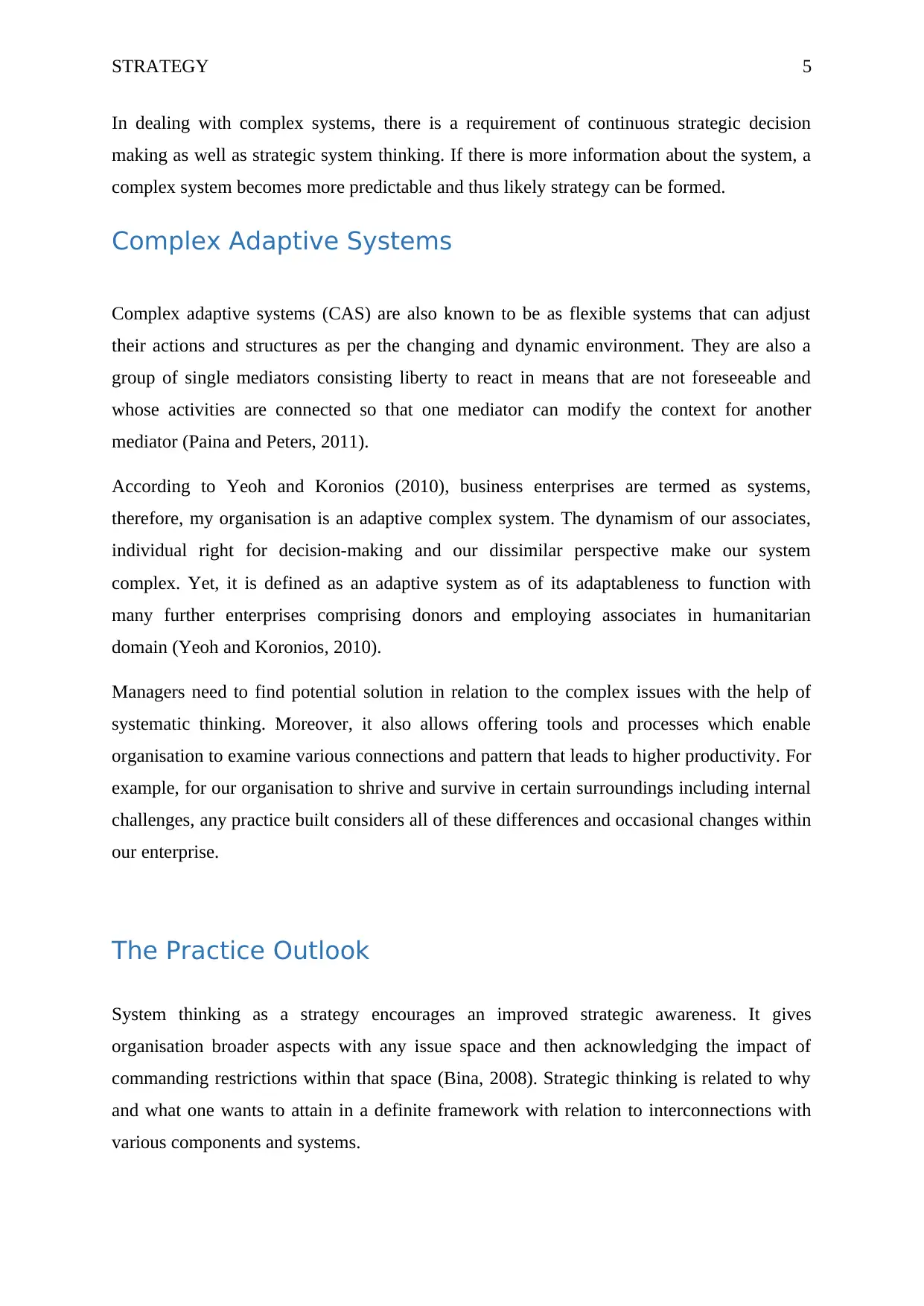
STRATEGY 5
In dealing with complex systems, there is a requirement of continuous strategic decision
making as well as strategic system thinking. If there is more information about the system, a
complex system becomes more predictable and thus likely strategy can be formed.
Complex Adaptive Systems
Complex adaptive systems (CAS) are also known to be as flexible systems that can adjust
their actions and structures as per the changing and dynamic environment. They are also a
group of single mediators consisting liberty to react in means that are not foreseeable and
whose activities are connected so that one mediator can modify the context for another
mediator (Paina and Peters, 2011).
According to Yeoh and Koronios (2010), business enterprises are termed as systems,
therefore, my organisation is an adaptive complex system. The dynamism of our associates,
individual right for decision-making and our dissimilar perspective make our system
complex. Yet, it is defined as an adaptive system as of its adaptableness to function with
many further enterprises comprising donors and employing associates in humanitarian
domain (Yeoh and Koronios, 2010).
Managers need to find potential solution in relation to the complex issues with the help of
systematic thinking. Moreover, it also allows offering tools and processes which enable
organisation to examine various connections and pattern that leads to higher productivity. For
example, for our organisation to shrive and survive in certain surroundings including internal
challenges, any practice built considers all of these differences and occasional changes within
our enterprise.
The Practice Outlook
System thinking as a strategy encourages an improved strategic awareness. It gives
organisation broader aspects with any issue space and then acknowledging the impact of
commanding restrictions within that space (Bina, 2008). Strategic thinking is related to why
and what one wants to attain in a definite framework with relation to interconnections with
various components and systems.
In dealing with complex systems, there is a requirement of continuous strategic decision
making as well as strategic system thinking. If there is more information about the system, a
complex system becomes more predictable and thus likely strategy can be formed.
Complex Adaptive Systems
Complex adaptive systems (CAS) are also known to be as flexible systems that can adjust
their actions and structures as per the changing and dynamic environment. They are also a
group of single mediators consisting liberty to react in means that are not foreseeable and
whose activities are connected so that one mediator can modify the context for another
mediator (Paina and Peters, 2011).
According to Yeoh and Koronios (2010), business enterprises are termed as systems,
therefore, my organisation is an adaptive complex system. The dynamism of our associates,
individual right for decision-making and our dissimilar perspective make our system
complex. Yet, it is defined as an adaptive system as of its adaptableness to function with
many further enterprises comprising donors and employing associates in humanitarian
domain (Yeoh and Koronios, 2010).
Managers need to find potential solution in relation to the complex issues with the help of
systematic thinking. Moreover, it also allows offering tools and processes which enable
organisation to examine various connections and pattern that leads to higher productivity. For
example, for our organisation to shrive and survive in certain surroundings including internal
challenges, any practice built considers all of these differences and occasional changes within
our enterprise.
The Practice Outlook
System thinking as a strategy encourages an improved strategic awareness. It gives
organisation broader aspects with any issue space and then acknowledging the impact of
commanding restrictions within that space (Bina, 2008). Strategic thinking is related to why
and what one wants to attain in a definite framework with relation to interconnections with
various components and systems.
⊘ This is a preview!⊘
Do you want full access?
Subscribe today to unlock all pages.

Trusted by 1+ million students worldwide
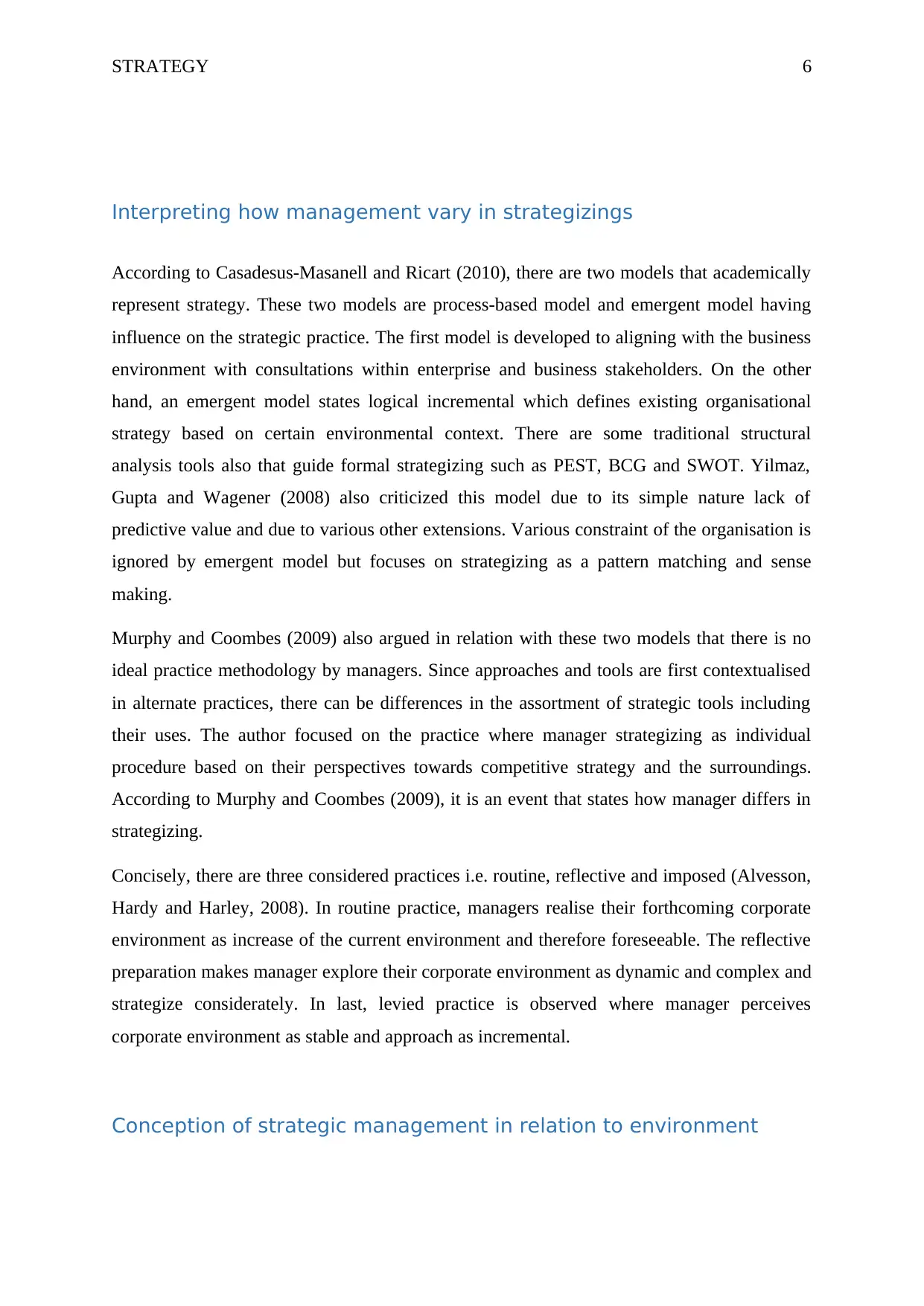
STRATEGY 6
Interpreting how management vary in strategizings
According to Casadesus-Masanell and Ricart (2010), there are two models that academically
represent strategy. These two models are process-based model and emergent model having
influence on the strategic practice. The first model is developed to aligning with the business
environment with consultations within enterprise and business stakeholders. On the other
hand, an emergent model states logical incremental which defines existing organisational
strategy based on certain environmental context. There are some traditional structural
analysis tools also that guide formal strategizing such as PEST, BCG and SWOT. Yilmaz,
Gupta and Wagener (2008) also criticized this model due to its simple nature lack of
predictive value and due to various other extensions. Various constraint of the organisation is
ignored by emergent model but focuses on strategizing as a pattern matching and sense
making.
Murphy and Coombes (2009) also argued in relation with these two models that there is no
ideal practice methodology by managers. Since approaches and tools are first contextualised
in alternate practices, there can be differences in the assortment of strategic tools including
their uses. The author focused on the practice where manager strategizing as individual
procedure based on their perspectives towards competitive strategy and the surroundings.
According to Murphy and Coombes (2009), it is an event that states how manager differs in
strategizing.
Concisely, there are three considered practices i.e. routine, reflective and imposed (Alvesson,
Hardy and Harley, 2008). In routine practice, managers realise their forthcoming corporate
environment as increase of the current environment and therefore foreseeable. The reflective
preparation makes manager explore their corporate environment as dynamic and complex and
strategize considerately. In last, levied practice is observed where manager perceives
corporate environment as stable and approach as incremental.
Conception of strategic management in relation to environment
Interpreting how management vary in strategizings
According to Casadesus-Masanell and Ricart (2010), there are two models that academically
represent strategy. These two models are process-based model and emergent model having
influence on the strategic practice. The first model is developed to aligning with the business
environment with consultations within enterprise and business stakeholders. On the other
hand, an emergent model states logical incremental which defines existing organisational
strategy based on certain environmental context. There are some traditional structural
analysis tools also that guide formal strategizing such as PEST, BCG and SWOT. Yilmaz,
Gupta and Wagener (2008) also criticized this model due to its simple nature lack of
predictive value and due to various other extensions. Various constraint of the organisation is
ignored by emergent model but focuses on strategizing as a pattern matching and sense
making.
Murphy and Coombes (2009) also argued in relation with these two models that there is no
ideal practice methodology by managers. Since approaches and tools are first contextualised
in alternate practices, there can be differences in the assortment of strategic tools including
their uses. The author focused on the practice where manager strategizing as individual
procedure based on their perspectives towards competitive strategy and the surroundings.
According to Murphy and Coombes (2009), it is an event that states how manager differs in
strategizing.
Concisely, there are three considered practices i.e. routine, reflective and imposed (Alvesson,
Hardy and Harley, 2008). In routine practice, managers realise their forthcoming corporate
environment as increase of the current environment and therefore foreseeable. The reflective
preparation makes manager explore their corporate environment as dynamic and complex and
strategize considerately. In last, levied practice is observed where manager perceives
corporate environment as stable and approach as incremental.
Conception of strategic management in relation to environment
Paraphrase This Document
Need a fresh take? Get an instant paraphrase of this document with our AI Paraphraser
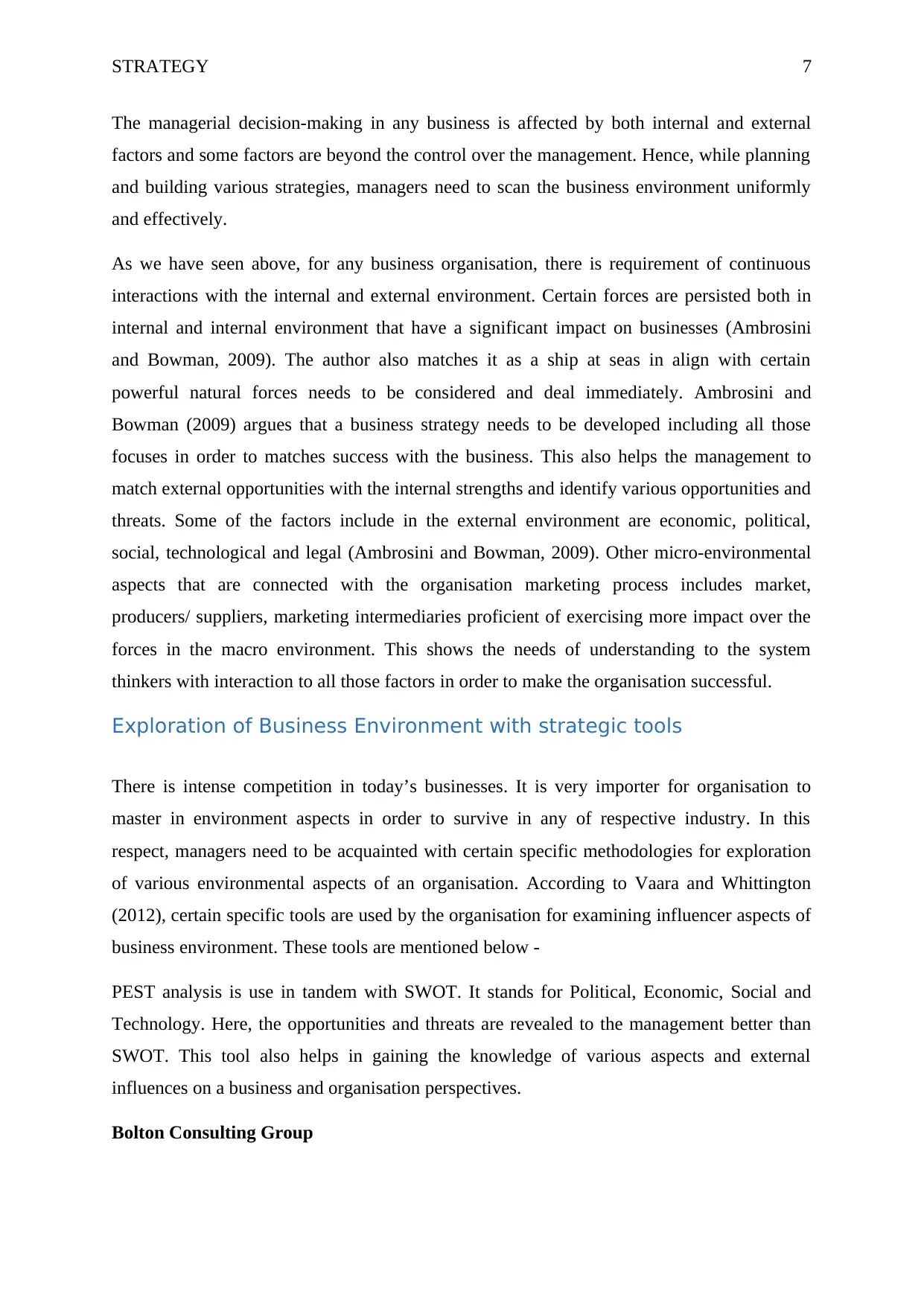
STRATEGY 7
The managerial decision-making in any business is affected by both internal and external
factors and some factors are beyond the control over the management. Hence, while planning
and building various strategies, managers need to scan the business environment uniformly
and effectively.
As we have seen above, for any business organisation, there is requirement of continuous
interactions with the internal and external environment. Certain forces are persisted both in
internal and internal environment that have a significant impact on businesses (Ambrosini
and Bowman, 2009). The author also matches it as a ship at seas in align with certain
powerful natural forces needs to be considered and deal immediately. Ambrosini and
Bowman (2009) argues that a business strategy needs to be developed including all those
focuses in order to matches success with the business. This also helps the management to
match external opportunities with the internal strengths and identify various opportunities and
threats. Some of the factors include in the external environment are economic, political,
social, technological and legal (Ambrosini and Bowman, 2009). Other micro-environmental
aspects that are connected with the organisation marketing process includes market,
producers/ suppliers, marketing intermediaries proficient of exercising more impact over the
forces in the macro environment. This shows the needs of understanding to the system
thinkers with interaction to all those factors in order to make the organisation successful.
Exploration of Business Environment with strategic tools
There is intense competition in today’s businesses. It is very importer for organisation to
master in environment aspects in order to survive in any of respective industry. In this
respect, managers need to be acquainted with certain specific methodologies for exploration
of various environmental aspects of an organisation. According to Vaara and Whittington
(2012), certain specific tools are used by the organisation for examining influencer aspects of
business environment. These tools are mentioned below -
PEST analysis is use in tandem with SWOT. It stands for Political, Economic, Social and
Technology. Here, the opportunities and threats are revealed to the management better than
SWOT. This tool also helps in gaining the knowledge of various aspects and external
influences on a business and organisation perspectives.
Bolton Consulting Group
The managerial decision-making in any business is affected by both internal and external
factors and some factors are beyond the control over the management. Hence, while planning
and building various strategies, managers need to scan the business environment uniformly
and effectively.
As we have seen above, for any business organisation, there is requirement of continuous
interactions with the internal and external environment. Certain forces are persisted both in
internal and internal environment that have a significant impact on businesses (Ambrosini
and Bowman, 2009). The author also matches it as a ship at seas in align with certain
powerful natural forces needs to be considered and deal immediately. Ambrosini and
Bowman (2009) argues that a business strategy needs to be developed including all those
focuses in order to matches success with the business. This also helps the management to
match external opportunities with the internal strengths and identify various opportunities and
threats. Some of the factors include in the external environment are economic, political,
social, technological and legal (Ambrosini and Bowman, 2009). Other micro-environmental
aspects that are connected with the organisation marketing process includes market,
producers/ suppliers, marketing intermediaries proficient of exercising more impact over the
forces in the macro environment. This shows the needs of understanding to the system
thinkers with interaction to all those factors in order to make the organisation successful.
Exploration of Business Environment with strategic tools
There is intense competition in today’s businesses. It is very importer for organisation to
master in environment aspects in order to survive in any of respective industry. In this
respect, managers need to be acquainted with certain specific methodologies for exploration
of various environmental aspects of an organisation. According to Vaara and Whittington
(2012), certain specific tools are used by the organisation for examining influencer aspects of
business environment. These tools are mentioned below -
PEST analysis is use in tandem with SWOT. It stands for Political, Economic, Social and
Technology. Here, the opportunities and threats are revealed to the management better than
SWOT. This tool also helps in gaining the knowledge of various aspects and external
influences on a business and organisation perspectives.
Bolton Consulting Group
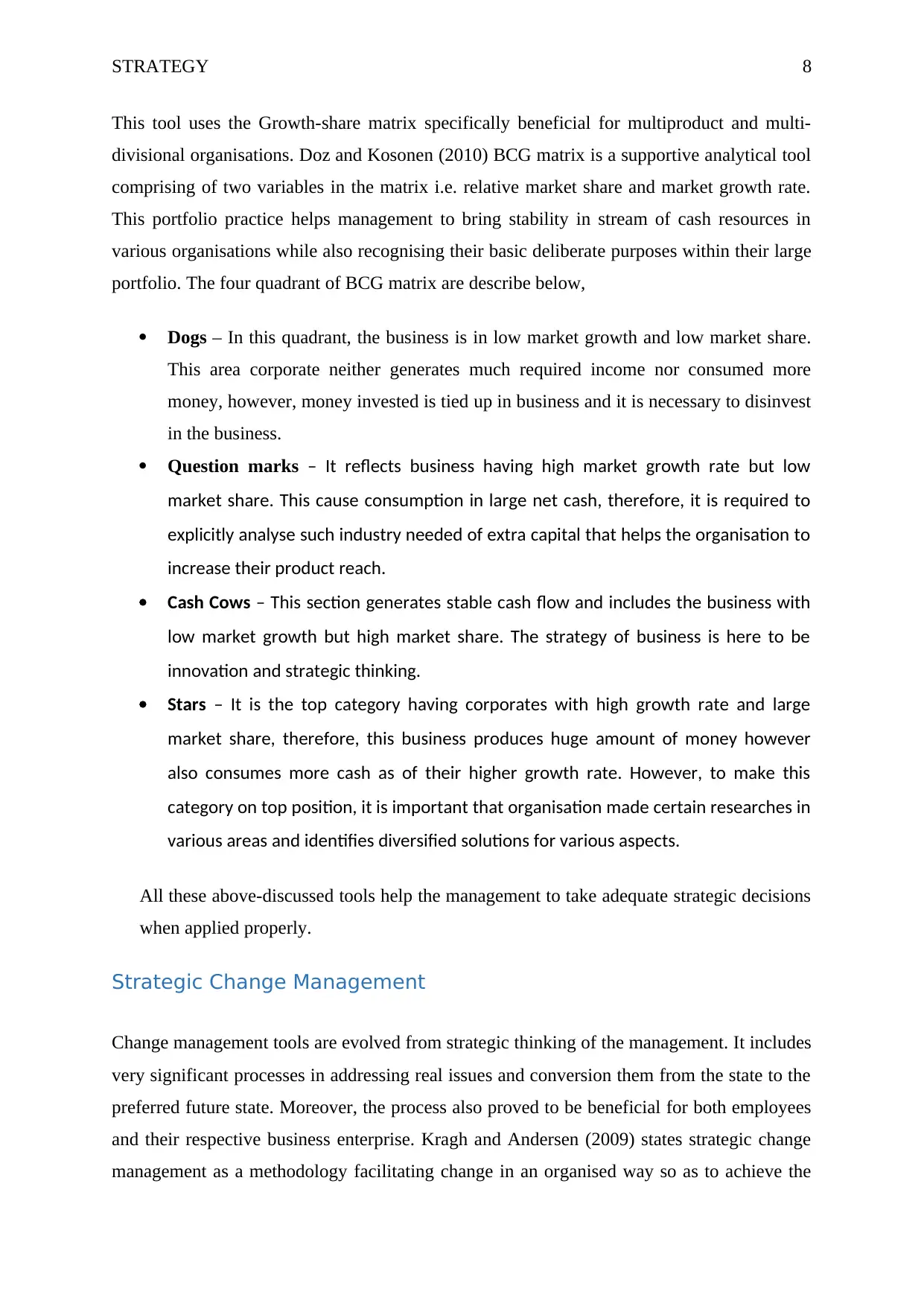
STRATEGY 8
This tool uses the Growth-share matrix specifically beneficial for multiproduct and multi-
divisional organisations. Doz and Kosonen (2010) BCG matrix is a supportive analytical tool
comprising of two variables in the matrix i.e. relative market share and market growth rate.
This portfolio practice helps management to bring stability in stream of cash resources in
various organisations while also recognising their basic deliberate purposes within their large
portfolio. The four quadrant of BCG matrix are describe below,
Dogs – In this quadrant, the business is in low market growth and low market share.
This area corporate neither generates much required income nor consumed more
money, however, money invested is tied up in business and it is necessary to disinvest
in the business.
Question marks – It reflects business having high market growth rate but low
market share. This cause consumption in large net cash, therefore, it is required to
explicitly analyse such industry needed of extra capital that helps the organisation to
increase their product reach.
Cash Cows – This section generates stable cash flow and includes the business with
low market growth but high market share. The strategy of business is here to be
innovation and strategic thinking.
Stars – It is the top category having corporates with high growth rate and large
market share, therefore, this business produces huge amount of money however
also consumes more cash as of their higher growth rate. However, to make this
category on top position, it is important that organisation made certain researches in
various areas and identifies diversified solutions for various aspects.
All these above-discussed tools help the management to take adequate strategic decisions
when applied properly.
Strategic Change Management
Change management tools are evolved from strategic thinking of the management. It includes
very significant processes in addressing real issues and conversion them from the state to the
preferred future state. Moreover, the process also proved to be beneficial for both employees
and their respective business enterprise. Kragh and Andersen (2009) states strategic change
management as a methodology facilitating change in an organised way so as to achieve the
This tool uses the Growth-share matrix specifically beneficial for multiproduct and multi-
divisional organisations. Doz and Kosonen (2010) BCG matrix is a supportive analytical tool
comprising of two variables in the matrix i.e. relative market share and market growth rate.
This portfolio practice helps management to bring stability in stream of cash resources in
various organisations while also recognising their basic deliberate purposes within their large
portfolio. The four quadrant of BCG matrix are describe below,
Dogs – In this quadrant, the business is in low market growth and low market share.
This area corporate neither generates much required income nor consumed more
money, however, money invested is tied up in business and it is necessary to disinvest
in the business.
Question marks – It reflects business having high market growth rate but low
market share. This cause consumption in large net cash, therefore, it is required to
explicitly analyse such industry needed of extra capital that helps the organisation to
increase their product reach.
Cash Cows – This section generates stable cash flow and includes the business with
low market growth but high market share. The strategy of business is here to be
innovation and strategic thinking.
Stars – It is the top category having corporates with high growth rate and large
market share, therefore, this business produces huge amount of money however
also consumes more cash as of their higher growth rate. However, to make this
category on top position, it is important that organisation made certain researches in
various areas and identifies diversified solutions for various aspects.
All these above-discussed tools help the management to take adequate strategic decisions
when applied properly.
Strategic Change Management
Change management tools are evolved from strategic thinking of the management. It includes
very significant processes in addressing real issues and conversion them from the state to the
preferred future state. Moreover, the process also proved to be beneficial for both employees
and their respective business enterprise. Kragh and Andersen (2009) states strategic change
management as a methodology facilitating change in an organised way so as to achieve the
⊘ This is a preview!⊘
Do you want full access?
Subscribe today to unlock all pages.

Trusted by 1+ million students worldwide
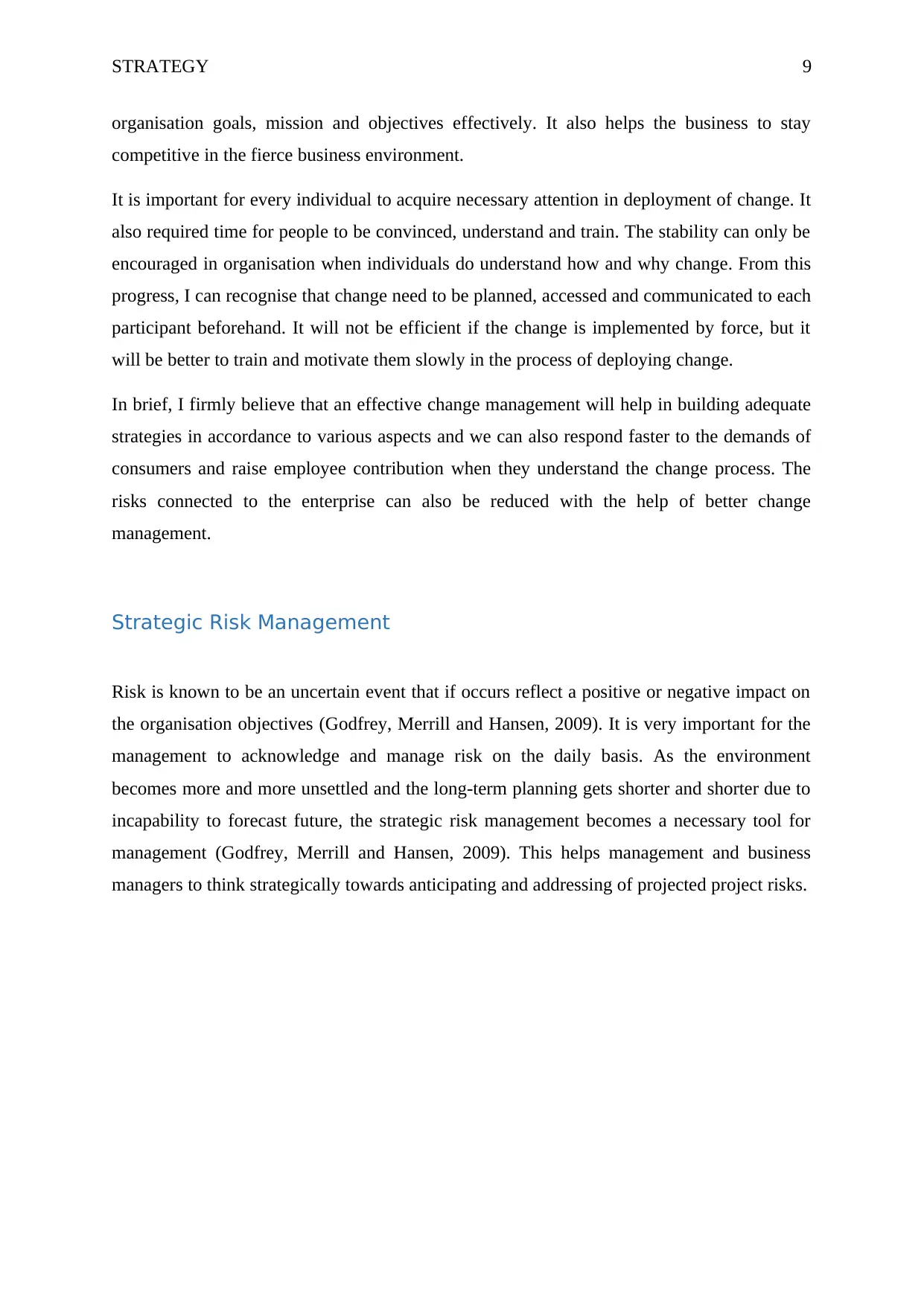
STRATEGY 9
organisation goals, mission and objectives effectively. It also helps the business to stay
competitive in the fierce business environment.
It is important for every individual to acquire necessary attention in deployment of change. It
also required time for people to be convinced, understand and train. The stability can only be
encouraged in organisation when individuals do understand how and why change. From this
progress, I can recognise that change need to be planned, accessed and communicated to each
participant beforehand. It will not be efficient if the change is implemented by force, but it
will be better to train and motivate them slowly in the process of deploying change.
In brief, I firmly believe that an effective change management will help in building adequate
strategies in accordance to various aspects and we can also respond faster to the demands of
consumers and raise employee contribution when they understand the change process. The
risks connected to the enterprise can also be reduced with the help of better change
management.
Strategic Risk Management
Risk is known to be an uncertain event that if occurs reflect a positive or negative impact on
the organisation objectives (Godfrey, Merrill and Hansen, 2009). It is very important for the
management to acknowledge and manage risk on the daily basis. As the environment
becomes more and more unsettled and the long-term planning gets shorter and shorter due to
incapability to forecast future, the strategic risk management becomes a necessary tool for
management (Godfrey, Merrill and Hansen, 2009). This helps management and business
managers to think strategically towards anticipating and addressing of projected project risks.
organisation goals, mission and objectives effectively. It also helps the business to stay
competitive in the fierce business environment.
It is important for every individual to acquire necessary attention in deployment of change. It
also required time for people to be convinced, understand and train. The stability can only be
encouraged in organisation when individuals do understand how and why change. From this
progress, I can recognise that change need to be planned, accessed and communicated to each
participant beforehand. It will not be efficient if the change is implemented by force, but it
will be better to train and motivate them slowly in the process of deploying change.
In brief, I firmly believe that an effective change management will help in building adequate
strategies in accordance to various aspects and we can also respond faster to the demands of
consumers and raise employee contribution when they understand the change process. The
risks connected to the enterprise can also be reduced with the help of better change
management.
Strategic Risk Management
Risk is known to be an uncertain event that if occurs reflect a positive or negative impact on
the organisation objectives (Godfrey, Merrill and Hansen, 2009). It is very important for the
management to acknowledge and manage risk on the daily basis. As the environment
becomes more and more unsettled and the long-term planning gets shorter and shorter due to
incapability to forecast future, the strategic risk management becomes a necessary tool for
management (Godfrey, Merrill and Hansen, 2009). This helps management and business
managers to think strategically towards anticipating and addressing of projected project risks.
Paraphrase This Document
Need a fresh take? Get an instant paraphrase of this document with our AI Paraphraser
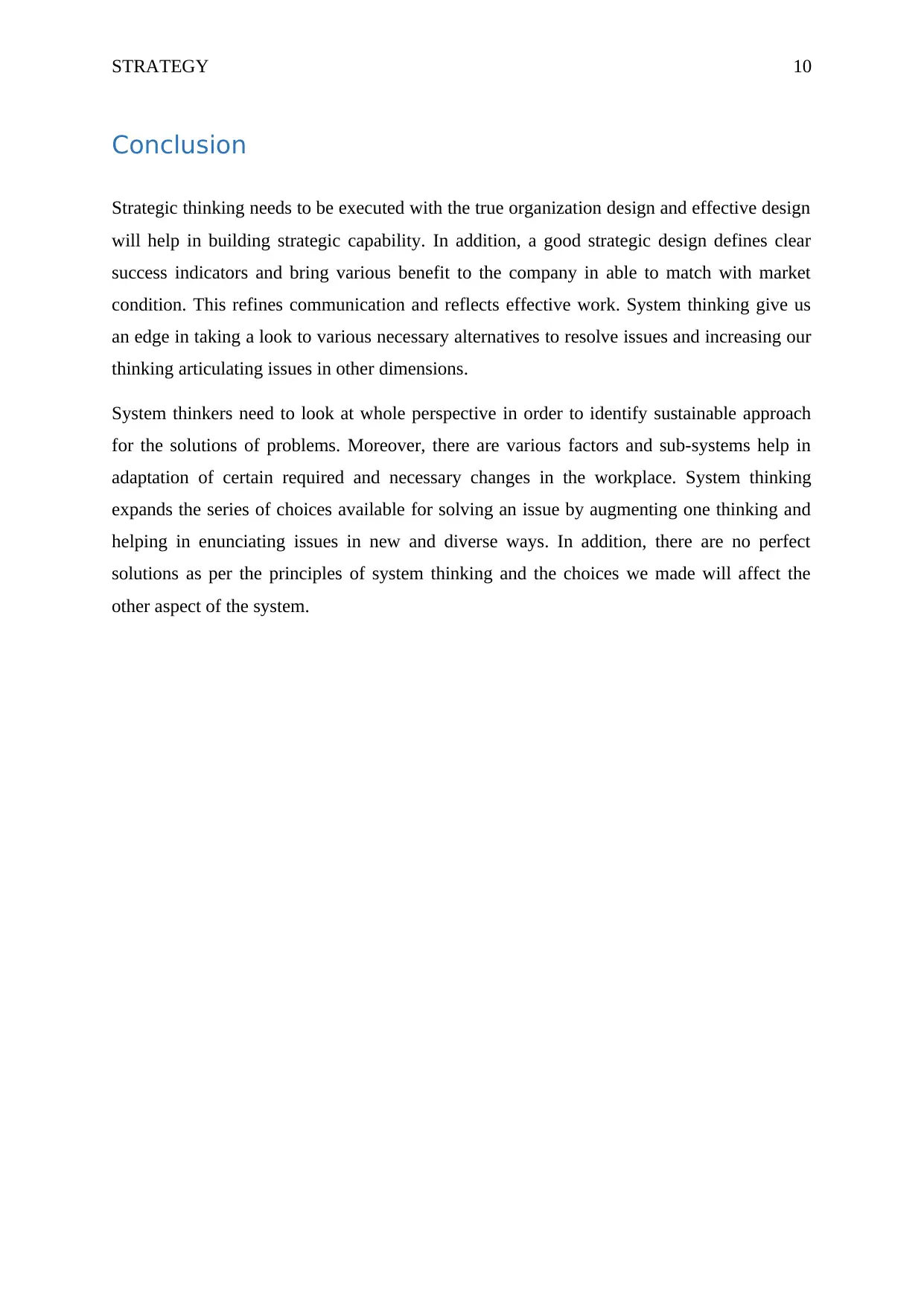
STRATEGY 10
Conclusion
Strategic thinking needs to be executed with the true organization design and effective design
will help in building strategic capability. In addition, a good strategic design defines clear
success indicators and bring various benefit to the company in able to match with market
condition. This refines communication and reflects effective work. System thinking give us
an edge in taking a look to various necessary alternatives to resolve issues and increasing our
thinking articulating issues in other dimensions.
System thinkers need to look at whole perspective in order to identify sustainable approach
for the solutions of problems. Moreover, there are various factors and sub-systems help in
adaptation of certain required and necessary changes in the workplace. System thinking
expands the series of choices available for solving an issue by augmenting one thinking and
helping in enunciating issues in new and diverse ways. In addition, there are no perfect
solutions as per the principles of system thinking and the choices we made will affect the
other aspect of the system.
Conclusion
Strategic thinking needs to be executed with the true organization design and effective design
will help in building strategic capability. In addition, a good strategic design defines clear
success indicators and bring various benefit to the company in able to match with market
condition. This refines communication and reflects effective work. System thinking give us
an edge in taking a look to various necessary alternatives to resolve issues and increasing our
thinking articulating issues in other dimensions.
System thinkers need to look at whole perspective in order to identify sustainable approach
for the solutions of problems. Moreover, there are various factors and sub-systems help in
adaptation of certain required and necessary changes in the workplace. System thinking
expands the series of choices available for solving an issue by augmenting one thinking and
helping in enunciating issues in new and diverse ways. In addition, there are no perfect
solutions as per the principles of system thinking and the choices we made will affect the
other aspect of the system.
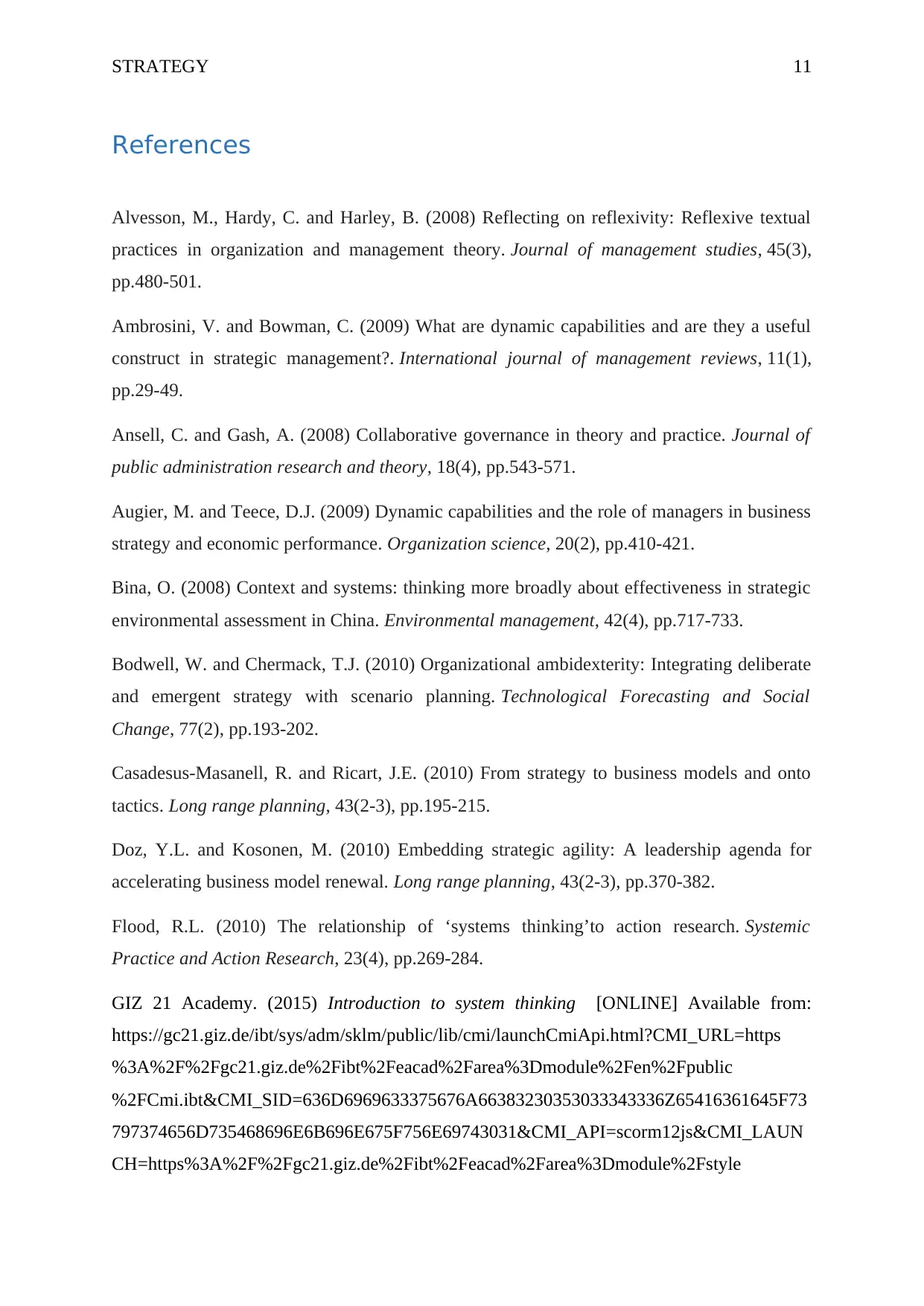
STRATEGY 11
References
Alvesson, M., Hardy, C. and Harley, B. (2008) Reflecting on reflexivity: Reflexive textual
practices in organization and management theory. Journal of management studies, 45(3),
pp.480-501.
Ambrosini, V. and Bowman, C. (2009) What are dynamic capabilities and are they a useful
construct in strategic management?. International journal of management reviews, 11(1),
pp.29-49.
Ansell, C. and Gash, A. (2008) Collaborative governance in theory and practice. Journal of
public administration research and theory, 18(4), pp.543-571.
Augier, M. and Teece, D.J. (2009) Dynamic capabilities and the role of managers in business
strategy and economic performance. Organization science, 20(2), pp.410-421.
Bina, O. (2008) Context and systems: thinking more broadly about effectiveness in strategic
environmental assessment in China. Environmental management, 42(4), pp.717-733.
Bodwell, W. and Chermack, T.J. (2010) Organizational ambidexterity: Integrating deliberate
and emergent strategy with scenario planning. Technological Forecasting and Social
Change, 77(2), pp.193-202.
Casadesus-Masanell, R. and Ricart, J.E. (2010) From strategy to business models and onto
tactics. Long range planning, 43(2-3), pp.195-215.
Doz, Y.L. and Kosonen, M. (2010) Embedding strategic agility: A leadership agenda for
accelerating business model renewal. Long range planning, 43(2-3), pp.370-382.
Flood, R.L. (2010) The relationship of ‘systems thinking’to action research. Systemic
Practice and Action Research, 23(4), pp.269-284.
GIZ 21 Academy. (2015) Introduction to system thinking [ONLINE] Available from:
https://gc21.giz.de/ibt/sys/adm/sklm/public/lib/cmi/launchCmiApi.html?CMI_URL=https
%3A%2F%2Fgc21.giz.de%2Fibt%2Feacad%2Farea%3Dmodule%2Fen%2Fpublic
%2FCmi.ibt&CMI_SID=636D6969633375676A66383230353033343336Z65416361645F73
797374656D735468696E6B696E675F756E69743031&CMI_API=scorm12js&CMI_LAUN
CH=https%3A%2F%2Fgc21.giz.de%2Fibt%2Feacad%2Farea%3Dmodule%2Fstyle
References
Alvesson, M., Hardy, C. and Harley, B. (2008) Reflecting on reflexivity: Reflexive textual
practices in organization and management theory. Journal of management studies, 45(3),
pp.480-501.
Ambrosini, V. and Bowman, C. (2009) What are dynamic capabilities and are they a useful
construct in strategic management?. International journal of management reviews, 11(1),
pp.29-49.
Ansell, C. and Gash, A. (2008) Collaborative governance in theory and practice. Journal of
public administration research and theory, 18(4), pp.543-571.
Augier, M. and Teece, D.J. (2009) Dynamic capabilities and the role of managers in business
strategy and economic performance. Organization science, 20(2), pp.410-421.
Bina, O. (2008) Context and systems: thinking more broadly about effectiveness in strategic
environmental assessment in China. Environmental management, 42(4), pp.717-733.
Bodwell, W. and Chermack, T.J. (2010) Organizational ambidexterity: Integrating deliberate
and emergent strategy with scenario planning. Technological Forecasting and Social
Change, 77(2), pp.193-202.
Casadesus-Masanell, R. and Ricart, J.E. (2010) From strategy to business models and onto
tactics. Long range planning, 43(2-3), pp.195-215.
Doz, Y.L. and Kosonen, M. (2010) Embedding strategic agility: A leadership agenda for
accelerating business model renewal. Long range planning, 43(2-3), pp.370-382.
Flood, R.L. (2010) The relationship of ‘systems thinking’to action research. Systemic
Practice and Action Research, 23(4), pp.269-284.
GIZ 21 Academy. (2015) Introduction to system thinking [ONLINE] Available from:
https://gc21.giz.de/ibt/sys/adm/sklm/public/lib/cmi/launchCmiApi.html?CMI_URL=https
%3A%2F%2Fgc21.giz.de%2Fibt%2Feacad%2Farea%3Dmodule%2Fen%2Fpublic
%2FCmi.ibt&CMI_SID=636D6969633375676A66383230353033343336Z65416361645F73
797374656D735468696E6B696E675F756E69743031&CMI_API=scorm12js&CMI_LAUN
CH=https%3A%2F%2Fgc21.giz.de%2Fibt%2Feacad%2Farea%3Dmodule%2Fstyle
⊘ This is a preview!⊘
Do you want full access?
Subscribe today to unlock all pages.

Trusted by 1+ million students worldwide
1 out of 14
Related Documents
Your All-in-One AI-Powered Toolkit for Academic Success.
+13062052269
info@desklib.com
Available 24*7 on WhatsApp / Email
![[object Object]](/_next/static/media/star-bottom.7253800d.svg)
Unlock your academic potential
Copyright © 2020–2025 A2Z Services. All Rights Reserved. Developed and managed by ZUCOL.




